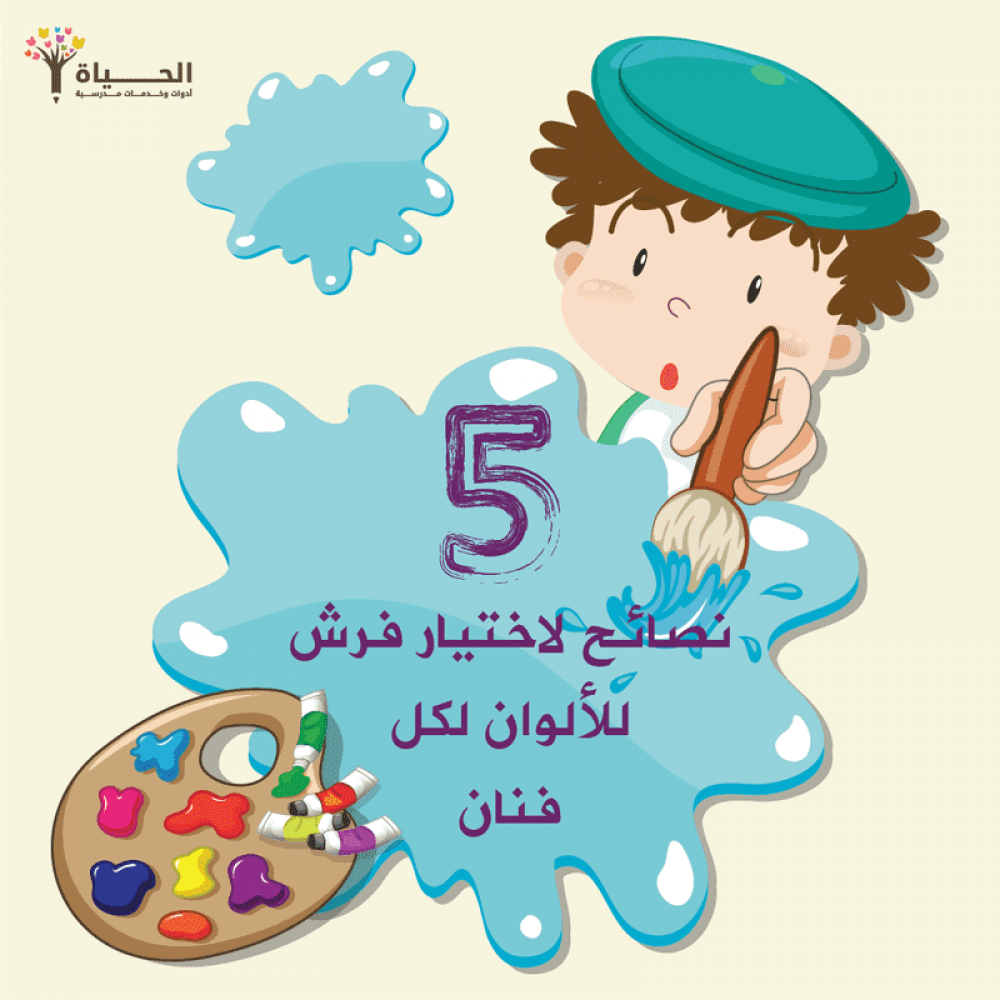
There are thousands of references for brushes for beginners and brushes for professional artists, each with its uses and characteristics. It is up to you to find the ones that are perfectly suited to your practice and needs, and we will help you, give you tips for choosing color brushes for every artist or beginner, and show you the best brushes on the market.
Which color brushes to choose?
To find the right brush for yourself, you must first proceed systematically, then with practice the process will become automatic, and you will be able to choose the optimal brush for each drawing. In general, there are 5 factors that must be taken into consideration when choosing a brush, which are the nature of the colors used, the type of bristles, their shape, and their size. We will discuss them. Today, but first let's figure out how to choose the quality of the brush at first glance:
How do you know the quality of the brush?
1- First, check the tips of the bristles and make sure they are well separated. The further apart the bristles are, the more paint the brush will absorb and the better the coloring will be.
2- Gently pull the bristles. If they separate, the brush is of poor quality. You can also press the bristles with the back of your hand to evaluate their elasticity. The rings tightly attached to the brushes ensure long-term use.
3- Check the brush against the light, as there should be no gaps between the bristles in the brush head. If so, they lack long whiskers.
4- Finally, the bristles should return to their original position after each use if the brush is good.
Now that you know how to identify quality color brushes, here's what sets them apart from others. Depending on the work you're about to do, some brushes will be more effective than others and will be perfect for making your job easier.
These are the most important standards and advice in this regard:
1- Choose brushes according to the type of colors
Choose brushes for watercolor
If you want to draw and paint with watercolors, you need a brush with a short handle for more maneuverability and bristles that have a strong ability to absorb and hold water permanently.
Natural bristle brushes are not recommended for watercolor paints because they absorb water, swell and lose elasticity.
The synthetic bristle brush does not swell with water and is therefore ideal for water-based colours, but can also be used for solvent-based paints.
This is one of the Life Shop suggestions:
- Faber-Castell Watercolor Pencils - Metal Box of 24 Colors and Free Brush.
- SBC 6 Pointed Watercolor Painting Brushes
In this article, you will learn about the best types of watercolors << 5 creative activities for children with the best watercolor brand .
Brushes for oil and acrylic colors:
Natural bristle brushes are resistant to solvents and are therefore recommended for application with solvent-based colors such as acrylics:
Our suggestions:
- Lino acrylic paint brushes, consisting of 6 pieces .
- Painting brushes for acrylic, oil and watercolors, containing 7 brushes from Fanbo
When painting with oils, you will need a set of brushes with soft, flat bristles with long hair because they are more flexible.
It is best to have all of these brushes in several copies, or a complete set of them, each brush for a specific color, in order to avoid cleaning your brushes during the session or smearing your colors:
Here are our collections of the finest paint brushes products:
- 4-Piece Oil, Acrylic and Watercolor Brush Set with Holder, Gray
- 5-Piece Oil, Acrylic and Watercolor Brush Set with Holder, Pink
- 12-Piece Oil, Acrylic and Watercolor Brush Set with Holder, Brown
- A set of 6 brushes for oil, acrylic and watercolor with a gray holder .
2- Choose brush bristles according to their nature
Brushes made with synthetic bristles last longer and clean more easily than natural bristles.
Brushes made of nylon, polyester, or a combination of the two are the most common synthetic bristles.
The difference between the two is that nylon bristles are more flexible and resistant, and are best used on rough surfaces, because they wear out less quickly, and they do not spread during coloring.
3-Choose the brush by its size
Short handle brushes:
Short-handed paintbrushes are used for working seated or at a table, and are more suitable for precise work and coloring of small or medium shapes, as they allow the wrist to be closer to the support.
We often find this type of brush for watercolor, ink, gouache, or other fluid techniques.
Long handle brushes:
Long-handled brushes are more suitable for upright work, as their long handle allows greater distance to be placed between the support and the artist's eye so that he can perceive his work as a whole.
Generally recommended for oil and acrylic, on large or medium formats, the long handle also facilitates greater gesture amplitude, flexibility of movement and better touch.
4- Choose the appropriate brush based on its shape:
As we have seen, there are different shapes of brushes.
Flat brushes:
There are different sizes and are often recommended for staining, smoothing or polishing large surfaces.
Here is this amazing collection:
- 6-piece painting brush set
- Oil paint brushes from the leading brand Fanbo. You will also find 6 brushes.
- Donia paint brush No. 20
Filling brushes:
These brushes are round and pointed and allow you to benefit from extreme precision. In general, they are used for corners, for example
- SBC Watercolor Painting Brush Set is a tapered shape of 6 brushes
- 12-Piece Oil, Acrylic and Watercolor Brush Set with Holder, Black
Special brushes:
They are the ones that are angled or called radiator tails that allow you to color fine drawings.
5- One final piece of advice
Buying high-quality color brushes is essential to ensure the quality of your painting. You will find reliable brands that respect the standards we mentioned above. We have suggested high-quality brands to you, and our final advice is to take care of the brushes as much as possible and clean them well.
To obtain these products from the Saudi Life Library Store , click on the links we have listed, or visit the art supplies section and choose colors and drawing brushes . You can choose between brushes and their accessories such as colors, a coloring plate, and other drawing tools as suits you.
You can also contact us via WhatsApp for all your inquiries, or learn more about our products and the best brands, and benefit from the valuable information we provide through the store’s blog:
What are the best types of pencils? Here are the experts' tips
The 32 Best Sketchbooks (International Brands Guide) of 2022

